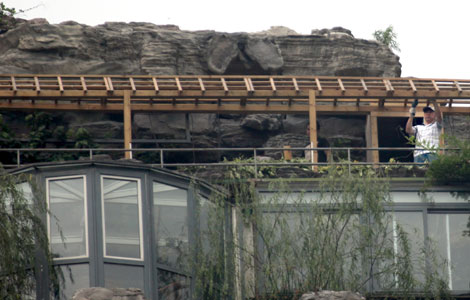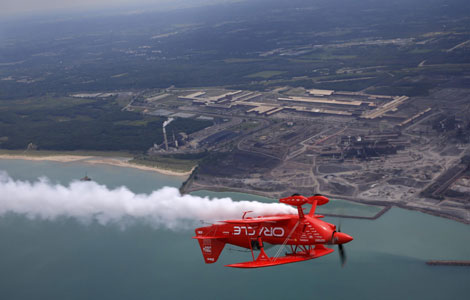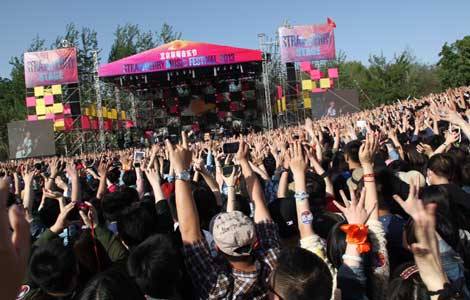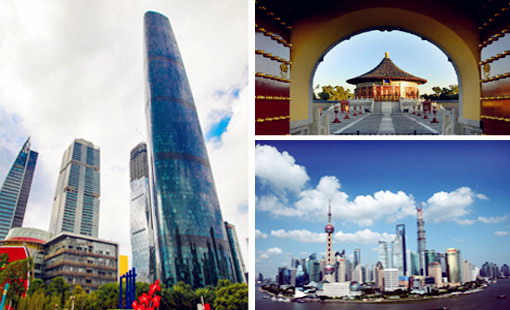Taller buildings, higher ambitions
Updated: 2013-08-16 08:52
By John Coulter (China Daily)
|
||||||||
The Shanghai Tower by Gensler Architects will not only be the second-tallest building in the world at 632 meters (think 6 football fields end on end into the sky), but also the technologies applied to build it are radical and revolutionary, and could pave the way to even taller buildings. The building will twist into space like a lithe and sprightly new tall kid on the block.
Given Shanghai residents' penchant for things novel, it will be the place to be - for work and for leisure. The top floors with views of the entire city, with the Huangpu River flowing below and the coastline at a slight distance, will besot negotiators and visionaries alike. Like with the world's tallest building, the Burj Khalifa, practicing yoga on its top floor could be the latest in thing to do in Shanghai.
Human beings have been trying to reach the sky since they built the Tower of Babel. European cathedrals aspire to loftiness. Skyscrapers capture our imagination and send egos soaring. "Meet you on the observation platform" is an invitation that makes us feel giddy.
The science of building skyward has a long history. Clay and bricks are structurally sound only to a certain height. In old China, given the intense pressure on space, the precious second floor required timber beams. In times of famine, though, the floorboards were stripped and sold off. Only in the 1960s did urban houses rise to 6 floors, limited by structural engineering and the prohibitive costs of elevators. By the 1980s, Shenzhen was copying Hong Kong to build 40-story buildings; the height was doubled in the next decade.
Beijing already had 50-story buildings when work on the 80-story World Trade Center Tower III started. And the rush to visit the top floor forced the management to set a high minimum rate for the eatery there.
But the hullabaloo in Shanghai over the new skyscraper again prompts the question: Are skyscrapers safe? Aren't they vulnerable to earthquakes and fire? Aren't they easy targets for terrorists? Statistically speaking, the dangers are minimum. Besides, after the Sept 11, 2001, attacks on the New York Twin Towers, offices in tall buildings have been equipped with devices to enable workers to parachute or hang-glide out of towering infernos. Drills have not been held because windows would have to be broken for that.
Skyscraper science will enable us to build even taller buildings. Materials science has evolved from brick making to iron smelting to making steel. Now we have wonder fibers that seem to defy gravity and help construct overhangs and leanings. A twisted building like the Shanghai Tower was unthinkable even a decade ago. At the heart of the new materials science is atomic topology pioneered by Richard Bader.
It was by accident that steel was cast out of iron. The crystalline structure in pig iron makes it brittle but a mix of 4 percent carbon transforms iron into steel and a little tweaking can make it strong enough to hold buildings that can weigh millions of tons. Bader's analysis tells us how atoms interlock. Atoms are not billiard balls but odd shaped jacks that may or may not fit together well. Today, thousands of labs are playing and testing with atom and molecule shapes to design new materials that turn skyscraper balconies into swimming pools, and build bedrooms with glass floors looking down on traffic half a kilometer below.
Skyscrapers scream wealth and technical mastery, and tell us much about civilization. For millennia the tallest structures were the pyramids of Egypt, then the cathedrals of England and Germany demanded reverence and tithing, followed by more than a century of US superiority in wealth, technology and brashness, led by New York and Chicago. Only during the past two and half decades has the East risen, with the world's tallest buildings in Kuala Lumpur, Taipei and now Dubai.
It seems an ominous foreboding that building of some of the world's tallest skyscrapers have coincided or have been followed by financial crises that killed the demand to occupy the heights. This was the experience of the Empire State Building, which celebrated its opening at the beginning of the Great Depression. The inauguration of the Petronas Towers in Kuala Lumpur coincided with the Asian financial crisis. And the current tallest building in the world opened during the global financial crisis and was forced to change its name from Burj Dubai to Burj Khalifa in honor of its bailout savior, UAE President Sheikh Khalifa bin Zayed Al Nahyan.
Let us hope the world's second tallest building in Shanghai signals continued and rising prosperity. The Chinese dream is not just a dream. It is a concept that has evolved from the hard lessons China has learned from recent past and a firm determination for the future. As part of China's urbanization drive, taller buildings are welcome provided they are built in a scientific way for efficient living and effective use of limited space. But the local authorities should take all the pros and cons into consideration before granting permission to build skyscrapers and ensure that the builders and developers follow all the safety norms and are fully aware of the financial risks.
The author is an Australian researcher collaborating with Chinese academic and commercial institutions.
(China Daily 08/16/2013 page9)

 Demolition work starts on rooftop villa structure
Demolition work starts on rooftop villa structure
 Thrills in store for Chicago Air and Water Show
Thrills in store for Chicago Air and Water Show
 Memorial to expeditionary soldiers opens
Memorial to expeditionary soldiers opens
 Death toll from Egypt violence rises to 638
Death toll from Egypt violence rises to 638
 Tunes that travel
Tunes that travel
 Macabre Addams Family tests musical tastes
Macabre Addams Family tests musical tastes
 Spielberg has desire to work with Zhang Yimou
Spielberg has desire to work with Zhang Yimou
 Li Na advances to 3rd round at Cincinnati Open
Li Na advances to 3rd round at Cincinnati Open
Most Viewed
Editor's Picks

|

|

|

|

|

|
Today's Top News
No remorse as Abe marks surrender anniversary
China to be world's No 1 consumer
China Mobile looks to data services
Beijing, Moscow hail military ties
Japan exports to China at lowest in four years
Fish ecosystem 'on verge of collapse'
First public rental housing fund launched
Trimming standard ideas of butchering
US Weekly

|

|








